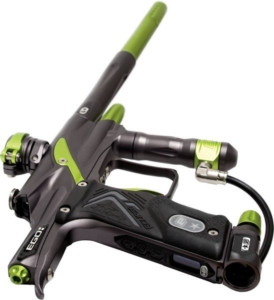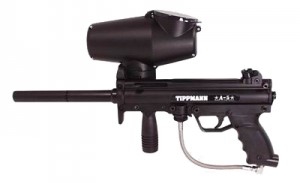The Parts of Your Paintball Marker
 When it comes to any sport, the quality of your equipment and your ability to use it can contribute to your success during your game. This is very true when it comes to your paintball marker.
When it comes to any sport, the quality of your equipment and your ability to use it can contribute to your success during your game. This is very true when it comes to your paintball marker.
There are many different models of paintball markers and many customizations you can add. With this in mind, it is good to know the basics of the different parts and the choices you have. This way you can customize your marker to complement your skills and help you be more successful during your AC Paintball game. To help you do so, AC Paintball has compiled this guide to paintball guns and their parts.
The Body
The body of your marker is pretty much a frame for all of the other components and helps hold everything together. It also makes up most of the aesthetic aspects of your gun. This is an aspect you will want to pay attention to when choosing a marker for your AC Paintball game. Bright colors look cool, but they also stand out more if you are trying to hide. Therefore, if stealth is one of your main goals, you may want to opt for a camouflaged marker or at least a dark color.
The Hopper
The hopper holds the paintballs. When it comes to paintball guns, there are three types of markers, force-feed, gravity-feed, and agitating loaders. If you want a high firing speed, force-feel or agitating loaders might be what you are looking for. However, it is worth noting that these types are also more prone to battery failure and moisture damage. The gravity-feed hoppers, on the other hand, are more durable, but also may experience more ball breaks which can jam the barrel.
 The Tank
The Tank
The tank is what propels the paintball out of the barrel when you pull the trigger. There are two types of tanks, CO2 and compressed air. Sometimes you have a choice between the two and other times you have to use a specific one if you don’t want to risk damaging your gun. Most paintball players choose CO2 because it is cheaper. However, compressed air tanks have a more consistent firing power than CO2 tanks. This means that you can be more precise and get better velocity when firing.
The Barrel
The barrel guides your paintball out of the gun after you pull the trigger. The barrel can affect how far the paintball flies, how accurately it flies, how fast it flies, and the loudness of your marker. For instance, longer barrels help make your shot more accurate and are quieter for players who are trying to be stealthy. On the other hand, shorter barrels can fire more rapidly and are typically a better choice for close combat. Be sure to keep these aspects in mind when choosing what marker to use for your next AC Paintball game.
Bolt, Sear, and Hammer
 The bolt, sear, and hammer work together to fire the paintball when you pull the trigger. The bolt controls the paintballs falling into the barrel. The hammer controls the release of the CO2 or compressed air in the tank. The sear is the part of the trigger that holds everything back until you pull it to command the gun to fire.
The bolt, sear, and hammer work together to fire the paintball when you pull the trigger. The bolt controls the paintballs falling into the barrel. The hammer controls the release of the CO2 or compressed air in the tank. The sear is the part of the trigger that holds everything back until you pull it to command the gun to fire.
To cock the gun before firing, you have to pull the bolt back towards the hammer. Then you have to push the two forward together. When you pull the trigger, everything will move in tandem to help propel the paintball out of the barrel.
Barrel Cover
Last, but not least there are barrel covers. Barrel covers protect the barrel and keep it from firing when you don’t want it to. You should always have the cover on when your marker is not in use. This way you can help ensure the safety of other AC Paintball guests.
Questions? Contact AC Paintball
If you have any questions or would like to schedule an AC Paintball game, you can contact us here: https://acpaintball.com/schedule-paintball-game/. You can also call us at 609-561-3883. We look forward to seeing you at our facility near Atlantic City, New Jersey!